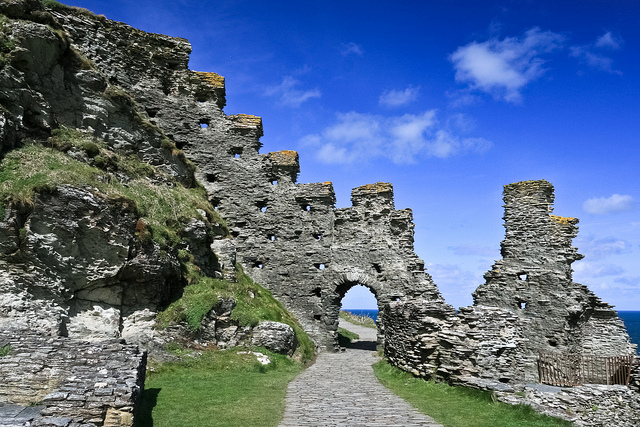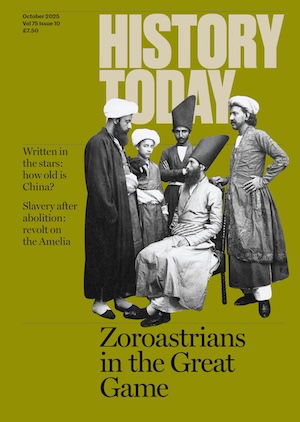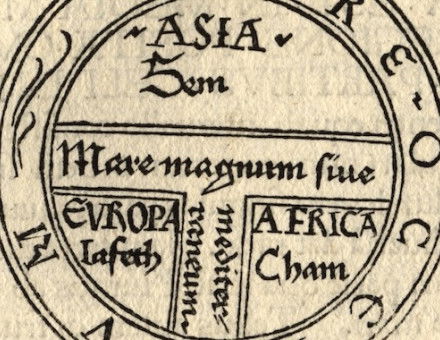The 'Dark Ages': The Tintagel Problem
In the debate over the term 'Dark Ages' the importance of Tintagel in early medieval Britain should not be forgotten.
 English Heritage’s use of the label ‘Dark Ages’ to describe the centuries between the ending of Roman Britain and the emergence of Anglo-Norman England (410-1066), has once again raised the issue of how we should define this most enigmatic of periods.
English Heritage’s use of the label ‘Dark Ages’ to describe the centuries between the ending of Roman Britain and the emergence of Anglo-Norman England (410-1066), has once again raised the issue of how we should define this most enigmatic of periods.
There is no doubt that ‘Dark Ages’ is an evocative label which resonates with the public, though whether this is justification enough for preferring this tag to other labels such as ‘early middle ages’, ‘migration period’ or ‘late antiquity’ is not entirely certain. While ‘migration period’ and ‘late antiquity’, in particular, are only valid as terms covering the initial part of the period 410-1066, institutions such as English Heritage have a responsibility to educate the wider public who visit their sites. Continuing to perpetuate the notion, one largely decried by academic historians, that these centuries were epitomised by ‘darkness’ can do little to further this important agenda.
Kate Wiles was justifiably critical of English Heritage’s labelling, suggesting instead that Anglo-Saxon England was illuminated by vernacular and Latin learning, artistry and governed by a strong system of kingship, predicated on written law, the production of coinage and the granting of charters. Yet, as Ian Mortimer’s response correctly points out, the characteristics identified by Kate Wiles as enlightening early Anglo-Saxon England appear only after the conversion of the various Anglian and Saxon kingdoms, a process which began with the Augustinian mission of 597. Rather, Mortimer suggests, Anglo-Saxon England prior to AD 600 was very much part of a darkened world, characterised by tumultuous violence and a lack of learning and civility.
There are certainly real differences between pre- and post-600 Anglo-Saxon England. Some, though not all, of these changes were the result of the increasing significance of Christianity at the courts of the Anglo-Saxon kings, with the hegemonic kingdom of Northumbria perhaps coming to exemplify the emergence of new forms of power and learning with the former diocese of Britannia. Mortimer is right therefore to suggest that the centuries between 410 and 1066 cannot be classified as one period. However, one would question the extent to which Mortimer’s ‘Dark Ages’, that is, 410-600, were more violent than any other period in medieval, or indeed, modern, history.
What should concern us most in this instance is not the use of the term ‘Dark Ages’ per se but rather the narrow, Anglocentric context with which this debate has taken place. One might argue that such a concern is unnecessary, particularly as this discussion arose in response to English Heritage’s periodisation. However, as English Heritage themselves have pointed out, the need to justify the label ‘Dark Ages’ relates, primarily, from their promotion of Tintagel Castle as tourist destination and the necessity to provide some form of interpretation to visitors.
The problem, then, is this: although English Heritage are now the custodians of Tintagel Castle, a site located on the Cornish coast, and Cornwall now forms part of England, this was not always the case. For much of English Heritage’s ‘Dark Ages’, Cornwall west of the river Tamar was located outside Anglo-Saxon ‘England’, in territory most scholars would recognise as being part of the Brittonic zone, an area populated by people grouped under the ethnonym ‘Britons’, which extended from Cornwall through modern Wales to what is now southern Scotland. Many of the inhabitants of this region, or their ancestors as the period progressed, were Roman citizens. Most, if not all, were Christians. They spoke British Celtic, ‘Cymraeg’ or Latin, though Irish was known, too. More than anything, the Britons regarded themselves as distinct from the intrusive, heathen Saxons.
Put simply, Tintagel was not in Anglo-Saxon ‘England’. In the fifth century, when Roman imperial ruled ceased in Britain, Cornwall was part of the civitas of the Dumnonii, a civilian administrative unit also including much, if not all, of modern Devon. By the sixth century, this territory was known as Dumnonia and its ruler, one Constantine, was castigated by Gildas in his De Excidio Britanniae, a loving denunciation of contemporary, Brittonic kings and clergy.
The rise of the West Saxons in the ninth and tenth centuries meant Cornwall eventually fell under Anglo-Saxon hegemony. Cornwall retained a distinct character within the early English kingdom, particularly in regards to linguistic and cultural identity; a distinctiveness retained into modern times. However, the complexity of Cornwall’s early relationship with England, at least as far as the general public is concerned, has been obscured by English Heritage’s control of the site and the subsequent debate as to whether Anglo-Saxon England was ‘dark’ or ‘light’, for the Brittonic region of which Cornwall was a part was defined by a different set of socio-political and cultural markers.
Much as it has troubled English Heritage, we can label this period in western Britain ‘late antiquity’ or the ‘early middle ages’. What, then, was it like in the late antique Brittonic zone? Examination of both the archaeological and textual evidence suggests early Brittonic society was illuminated by learning. Take Gildas for example. Ian Mortimer used him to illustrate the barbarity and violence of the age. Other scholars are more inclined to highlight Gildas’ education, the complexity of his Latin, his training rhetoric and his knowledge of the Bible and other texts, such as the Aeneid. Some of Gildas’ high-status audience of kings, clergy and noblepersons would have been educated to a similar standard. Constantine of Dumnonia, the ruler whose territory included Tintagel, was one king addressed by Gildas. Another was one Maglocunus, who, according to Gildas, had the ‘most refined master of almost all Britain’ as his personal mentor.
The inscribed funerary stones of western Britain further indicate that the Brittonic zone possessed a powerful church with a thriving ecclesiastical culture, predicated on knowledge of Latin. Significantly, these monuments show that the Britons were in communication with other groups of Roman citizens in places such as Gaul and North Africa. Belonging to a community of citizens still mattered, as did expressing this affiliation to the Roman state through a common set of symbols and the language of high authority: Latin. From Penmachno, just off the modern A5 in Gwynedd, is a remarkable inscribed stone declaring loyalty to the eastern Roman emperor Justin during the period of his successive consulship (567-579).
But what of Tintagel? The site itself, with its Arthurian connections, appears to be the epitome of a ‘dark age’ redoubt. Perched precariously on the Cornish coast one could imagine that Tintagel was cut off from the world. However, at least in parts of the sixth century, the opposite appears to have been the case. Tintagel and its inhabitants were thriving. Excavators have recovered from Tintagel the largest amount of Mediterranean pottery from any site in post-Roman Britain. These now smashed pots could possibly represent the cargo of a single trading vessel that landed at Tintagel at some point in the sixth century. But it seems more likely that Mediterranean traders, having collected goods such as olive oil and other commodities from sites in modern Turkey and North Africa, visited the windswept Cornish coast on a number of occasions in the sixth century. What these traders sought in return has never been fully ascertained: the late Charles Thomas, the scholar who did so much to illuminate the significance of ‘dark age’ Tintagel, suggested tin might have been high on the list of priorities. In any case, Tintagel was important and so, too, were its rulers.
Debating the significance of the term ‘dark ages’ will continue. But we should take care to ensure, when defining any period, that our analyses reflect the diversity and complexity of the past, and do not, intentionally or otherwise, obscure political, cultural or social realities which once existed in the areas now controlled by modern heritage bodies.
Edwin Hustwit recently completed a PhD at the University of Bangor on identity and ethnicity amongst the late Roman/early medieval Britons.






